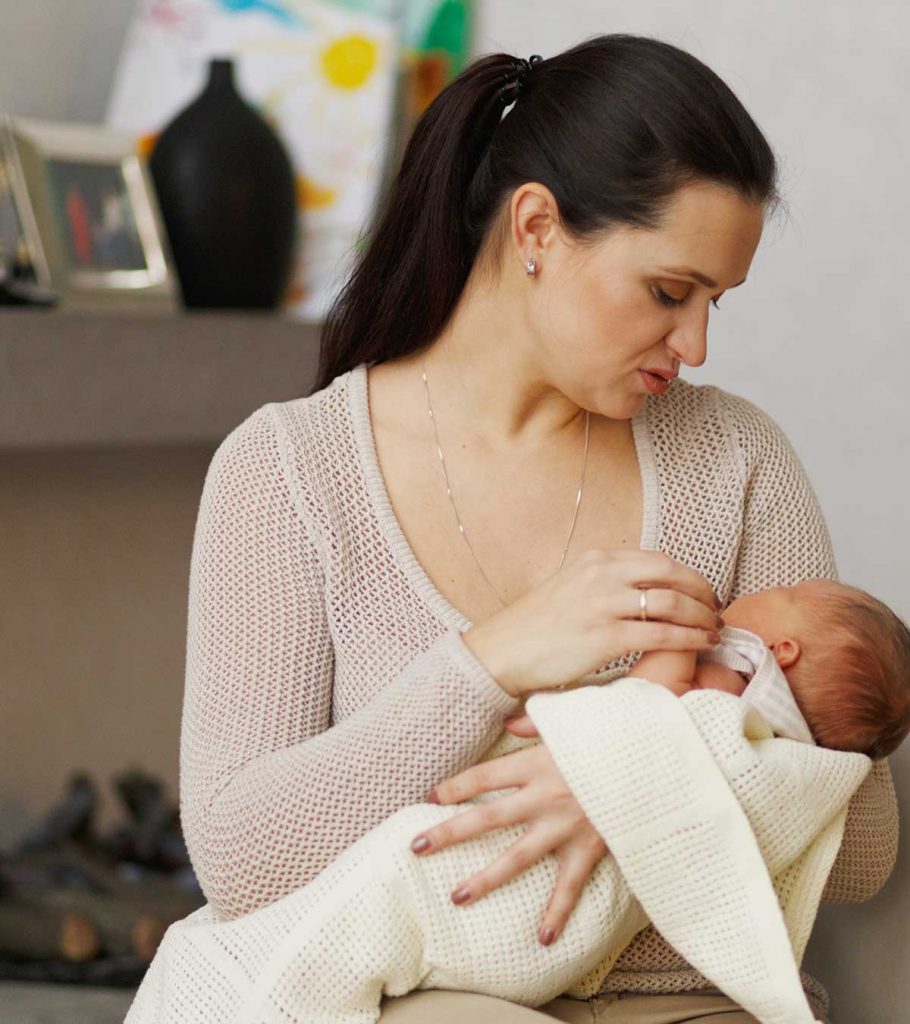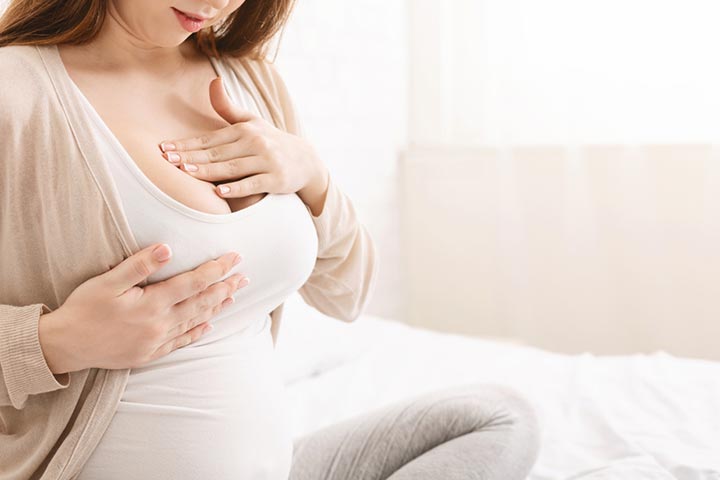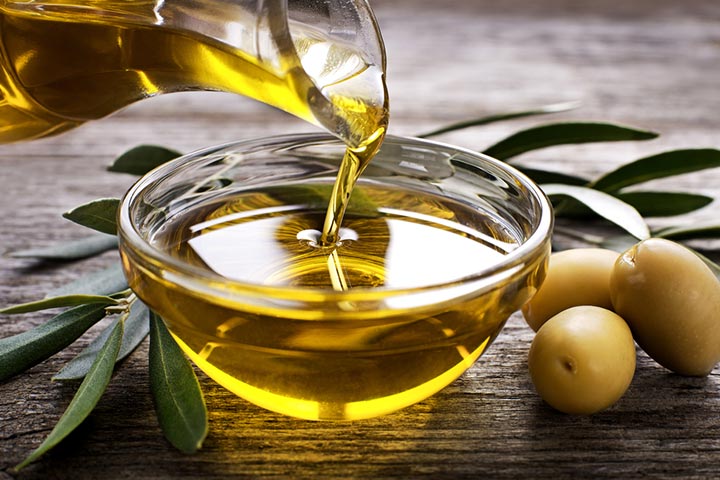Painful nipples or breasts are one of the top three reasons women stop breastfeeding earlier than usual (1). Nipple blisters while breastfeeding can cause pain and discomfort to the mother. A nipple blister may appear suddenly and does not cause any problems for most women. However, at times, it may get in the way of breastfeeding. No medical intervention is required for blisters that do not hurt, and some home remedies may aid in faster healing. In this post, we discuss the causes and management of nipple blisters.
What Causes A Nipple Blister?
Nipple blisters can be categorized based on what causes them.
- Friction blister: The repeated friction caused by an infant sucking at the nipple could cause a nipple blister. However, this is most likely to occur when the baby is not latched to the nipple correctly. The abnormal rubbing of the tongue and other parts of the mouth against the nipple can cause constant irritation on the skin, leading to inflammation and blistering (2).
- Milk blister: This type of nipple blister is also called nipple bleb or white spot (3). The cause of nipple bleb is unknown. However, it may occur when the dead skin traps a tiny amount of milk underneath the nipple, thus closing it within a blister (4). Milk blisters may also occur if a milk duct is blocked. These blisters can be more severe compared to frictional blisters. Therefore, it is essential to know how to spot a nipple blister.
Kate H shares her journey as a breastfeeding mother with a nipple bleb on her blog. She says, “When my milk came in — it was a huge relief for me, but breastfeeding still wasn’t picture perfect. I had a strange blister-like protrusion on my nipple but it was full of milk or what appeared to be milk. If it was just something that looked funny, I would probably have ignored it and only worried about it if it stuck around but this thing hurt like, a lot. It made me come very close to screaming while breastfeeding. I tried different interventions to relieve it but not much seemed to help. I also, of course, called my midwife and made sure it wasn’t anything to worry about — it would pass. Lots of creams — I used coconut oil and Lansinoh cream to good effect. But it sure took its time going away, or it felt that way. In reality, I think it was only a day or two — but in the postpartum mind, days can feel very long (i)!”
Apart from these, thrush and excessive milk supply can also lead to nipple blisters. In the case of thrush, which is a yeast infection, there will be multiple blisters that appear like a rash.
What Are The Symptoms Of A Nipple Blister?
Nipple blisters can be tiny and hard to spot. Check for the following signs that indicate the presence of a nipple
blister (3):
- An abnormal bump on the tip of the nipple and around it. If you run your finger on your nipple, you can feel the bump.
- A clear or white spot at the tip of the nipple. A white spot is mostly a milk blister.
- Gently pressing/squeezing the nipple between your thumb and index finger causes a tiny bulge to appear right at the tip of the nipple. It is more prominent in the case of a milk blister, which is white.
- The affected area might feel warm and tender or appear red and swollen.
- You may experience a dull pain from the tip of the nipple. A blocked duct will be more painful before a feeding and less tender after you breastfeed or use a breast pump.
While most nipple blisters are harmless, there are situations when a doctor must check them.
Home Remedies For Nipple Blisters
Home remedies can be the first choice when the blister does not seem to cause any pain. The following steps work as home remedies and preventive measures for nipple blisters (5):
- Apply olive oil:A randomized study of 300 lactating women demonstrated that extra virgin olive oil has protective effects on the skin (6). This protective effect might help in relieving pain by unclogging of the blister. Soak a cotton ball in olive oil and place it on the nipple for a day. Make sure you wipe the olive oil off with a fresh cotton ball before the baby feeds.
- Use Epsom salt: Epsom salt solution can help reduce the blisters. To make it, add two teaspoons Epsom salt to the warm water. Soak a cotton bud into the solution and apply it to the blister. This remedy is believed to soften the pore.
- Use warm compress before breastfeeding: A review study showed that warm compress might help relieve nipple pain (7). Take a napkin soaked in warm water and compress the nipple each time before you feed your baby. The warmth from the cloth can allow the dead skin to fall off and the thickened milk to flow freely through the nipple, thus relieving the nipple pain.
- Massage and feed from the affected breast first: Nipple blister pain caused by blockage could be mitigated by massage. For this, make circular strokes with your index finger above the areolar region or make straight strokes from the top of the breast towards the nipple (8). This will help stimulate the flow of milk through the ducts and help remove any blockage that causes a blister.
- Pump some milk out: Use a hospital-grade pump to express some milk from the affected breast. The pressure from the pump can help uncover the blister and allow for a smooth flow of milk when the baby breastfeeds. Expressing milk can also alleviate any pressure within the milk ducts.
- Improve latching position: A poor latch could lead to friction at the nipple and formation of a blister, besides resulting in poor feeding and accumulation of milk within the breasts. This could increase the risk of a clogged nipple blister. Thus, the latching position is vital and must be discussed with a lactation consultant if needed.
- Reduce nipple friction: Sometimes, a clear nipple blister could be a result of constant friction to your nipple. Women tend to wear plastic nipple shells to catch leaked milk or stretch the inverted nipple. If the shell is not of the right size or is worn all day, it can continuously rub against the skin and cause blisters. So, choose soft cotton pads instead of plastic for this purpose. Even if you pick plastic, buy one that is a perfect fit for your nipple and avoid wearing it for too long.
- Use ointments: The use of some nipple creams, especially the ones containing lanolin, could provide relief from the pain caused by friction (2). However, before using such ointment, check with your doctor about its safety, efficacy, directions to use, etc.
- Lecithin: Lecithin is generally “regarded as safe” (GRAS) by the US FDA. Lecithin supplements are recommended as a treatment for plugged milk ducts. However, it must be used under medical guidance only (9).
- Salt water rinse: A salt water rinse before breastfeeding results in milk duct dilation and expedites recovery. Making a salt-soaked solution is easy. First, mix half a teaspoon of salt into a small amount of boiling water. Then, add cold water until the right temperature for soaking is reached. Incorporate this salt water-soaking exercise into your regimen at least four times daily. Immediately following the soak, apply a warm, moist compress to the milk blister/bleb. Exercise caution to prevent burns during this process. Incorporating this practice into your routine can enhance the healing process and promote overall breast health (10).
These home remedies could help in relieving pain and might also help in alleviating the conditions causing the blisters. But if you find no relief, you can seek the doctor’s advice.
When To See A Doctor?
If you experience any of the following symptoms, then you must visit a doctor:
- Painful swelling of the nipple, including the areolar region.
- The blister continues to increase in size and gets more painful.
- A yellowish-white liquid comes out of the nipple.
- Decreased or no flow of milk from the nipple.
- Bleeding through the nipple. Extreme soreness and redness in the nipple region.
- Burning sensation every time the milk flows out of the nipple.
- You feel a lump underneath the nipple or anywhere around the breast. It could be due to the formation of a milk cyst, which is an accumulation of breast milk within the milk duct. It is medically called galactocele (11).
- You have recurring nipple blisters. It could be a result of some underlying problem or due to poor latching by the baby. Severe symptoms like burning, bleeding, and yellowish discharge from the nipple are all signs of an infection like mastitis, a condition that should be addressed immediately (12).
How Are Nipple Blisters Treated?
Lactation experts state that if a nipple blister does not hurt, then you should not do anything (4). It will heal on its own. But if the blister is painful and interferes with breastfeeding, then the doctor may use the following steps to ease the discomfort:
- Easing the blister through pressure: A slight pressure to the milk blister can help open it and relieve the trapped milk within. The doctor may rub some antiseptic liquid to the nipple to prevent any germs from invading the nipple when the blister ruptures.
- Opening the blister manually: If the blister does not break by hand, then a sterile needle could be used to remove the blockage manually. The contents of the blister are then be drained.
- Using antibiotic and anti-inflammatory medicines: After the doctor ruptures the blister, antibiotics, and anti-inflammatory medicines compatible with breastfeeding have to be used. If the blister formation is due to infection, then antibiotics will be the first line of treatment.
At times, nipple blisters might recur even after treatment. You can, however, keep them at bay by taking a few preventive measures.
Preventive Steps For Nipple Blisters
- Keep yourself hydrated as it will support milk flow and prevent dehydration.
- Eat healthy food for active immunity, which can help you fight off infections causing nipple blisters.
- Clean the nipples before and after feeding to remove milk from them and avoid clogging of pores nipple, which could clog pores.
- Seek help from lactation consultant about any issues related to latching and milk supply.
- Address any infections such as thrush promptly.
Nipple blisters while breastfeeding are common, but they may cause discomfort because of the pain and inflammation. These blisters may be caused due to several reasons and present themselves in the form of an unusual bump or white spot. Most blisters do not require medical treatment and do well with applying olive oil or using a warm compress. However, if your nipple blister is swollen, gives out yellowish-white liquid, or bleeds, you should consult a doctor for medical advice. Always adhere to the preventive steps to avoid such blisters.
Key Pointers
- Nipple blisters can be caused by friction from breastfeeding, blocked milk ducts, or excessive milk supply.
- Symptoms of nipple blisters include abnormal bumps, white spots, tenderness, and pain.
- Home remedies for nipple blisters include applying olive oil, using Epsom salt, warm compress, massage, and feeding from the affected breast first, and pumping milk.
- Seek medical attention if the blister grows or becomes recurring, lowers milk flow, or causes a burning sensation.
Nipples are sensitive and breastfeeding can cause blisters on them. So, what can you do to treat them? This video will explain how to soothe the pain and get rid of the blisters.














